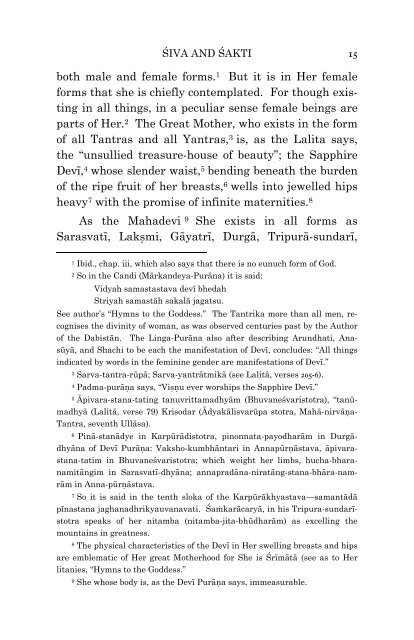Introduction to Tantra Sastra - Aghori
Introduction to Tantra Sastra - Aghori
Introduction to Tantra Sastra - Aghori
You also want an ePaper? Increase the reach of your titles
YUMPU automatically turns print PDFs into web optimized ePapers that Google loves.
ŚIVA AND ŚAKTI 15<br />
both male and female forms. 1 But it is in Her female<br />
forms that she is chiefly contemplated. For though existing<br />
in all things, in a peculiar sense female beings are<br />
parts of Her. 2 The Great Mother, who exists in the form<br />
of all <strong>Tantra</strong>s and all Yantras, 3 is, as the Lalita says,<br />
the “unsullied treasure-house of beauty”; the Sapphire<br />
Devī, 4 whose slender waist, 5 bending beneath the burden<br />
of the ripe fruit of her breasts, 6 wells in<strong>to</strong> jewelled hips<br />
heavy 7 with the promise of infinite maternities. 8<br />
As the Mahadevi 9 She exists in all forms as<br />
Sarasvatī, Lakṣmi, Gāyatrī, Durgā, Tripurā-sundarī,<br />
1 Ibid., chap. iii, which also says that there is no eunuch form of God.<br />
2 So in the Candi (Mārkandeya-Purāna) it is said:<br />
Vidyah samastastava devī bhedah<br />
Striyah samastāh sakalā jagatsu.<br />
See author’s “Hymns <strong>to</strong> the Goddess.” The Tantrika more than all men, recognises<br />
the divinity of woman, as was observed centuries past by the Author<br />
of the Dabistān. The Linga-Purāna also after describing Arundhati, Anasūyā,<br />
and Shachi <strong>to</strong> be each the manifestation of Devī, concludes: “All things<br />
indicated by words in the feminine gender are manifestations of Devī.”<br />
3 Sarva-tantra-rūpā; Sarva-yantrātmikā (see Lalitā, verses 205-6).<br />
4 Padma-purāṇa says, “Viṣ ṇu ever worships the Sapphire Devī.”<br />
5 Āpivara-stana-tating tanuvrittamadhyām (Bhuvaneśvaris<strong>to</strong>tra), “tanūmadhyā<br />
(Lalitā, verse 79) Krisodar (Ādyakālisvarūpa s<strong>to</strong>tra, Mahā-nirvāṇa-<br />
<strong>Tantra</strong>, seventh Ullāsa).<br />
6 Pinā-stanādye in Karpūrādis<strong>to</strong>tra, pinonnata-payodharām in Durgādhyāna<br />
of Devī Purāṇa: Vaksho-kumbhāntari in Annapūrṇāstava, āpivarastana-tatim<br />
in Bhuvaneśvaris<strong>to</strong>tra; which weight her limbs, hucha-bharanamitāngim<br />
in Sarasvatī-dhyāna; annapradāna-niratāng-stana-bhāra-namrām<br />
in Anna-pūrṇāstava.<br />
7 So it is said in the tenth sloka of the Karpūrākhyastava—samantādā<br />
pīnastana jaghanadhrikyauvanavati. Śaṃ<br />
karācaryā, in his Tripura-sundarīs<strong>to</strong>tra<br />
speaks of her nitamba (nitamba-jita-bhūdharām) as excelling the<br />
mountains in greatness.<br />
8 The physical characteristics of the Devī in Her swelling breasts and hips<br />
are emblematic of Her great Motherhood for She is Śrīmātā (see as <strong>to</strong> Her<br />
litanies, “Hymns <strong>to</strong> the Goddess.”<br />
9 She whose body is, as the Devī Purāṇa says, immeasurable.

















